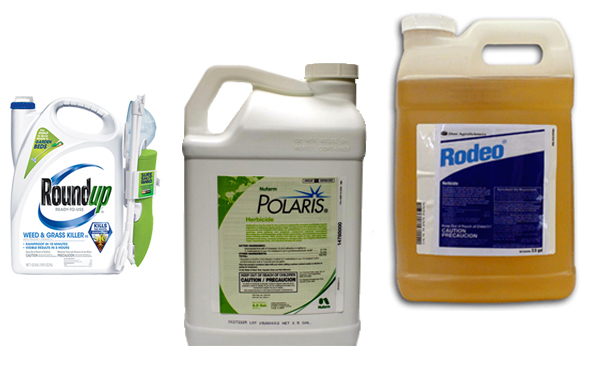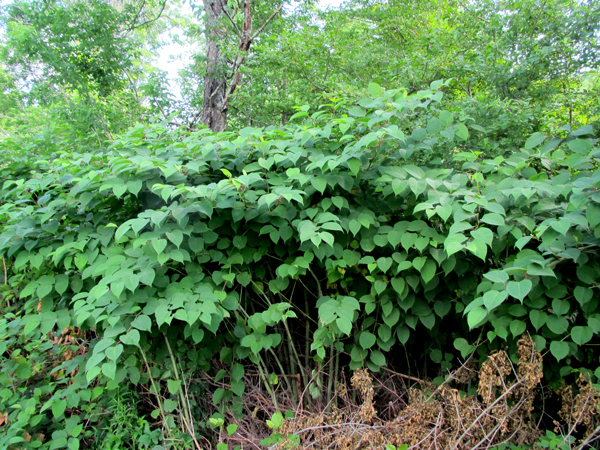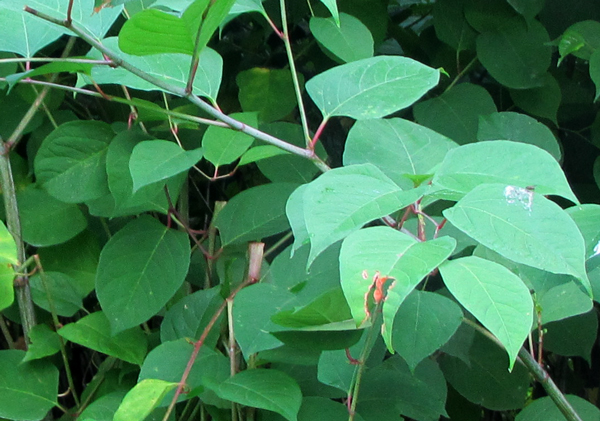|
UPDATE: For the Record: Rose Paul is with The Nature Conservancy in Vermont, not the Trust for Public Lands as was reported in The Valley Reporter's July 13 article about a proposal to use herbicides to treat knotweed on the Austin parcel in Waitsfield. This online version has been updated to reflect this change. |
The Waitsfield Conservation Commission’s plans to try a pilot project to contain Japanese knotweed on the five-acre Austin parcel using an herbicide has resulted in controversy on social media.
Last week The Valley Reporter reported that the Waitsfield Select Board OK’d a proposal by the conservation commission to address invasives on the parcel of town-owned land using a combination of the herbicide Rodeo (active ingredient glyphosate) and Polaris (active ingredient imazapyr). It will be applied in a backpack sprayer and with a motorized sprayer by the contractor Redstart Forestry.
It is one part of a plan to try to restore native species forest on the parcel to over-canopy and discourage knotweed and other nonnative invasives. The proposed project includes mowing a buffer strip between the knotweed at the water’s edge and the field where trees will be planted. Knotweed will be cut down in August and before the first frost, and the herbicides will be applied to it each time.

ISSUE EXPLODED
Earlier this week, the issue exploded on social media when James Ehlers, executive director of Lake Champlain International, raised the issue on Facebook. His post prompted many more comments about the dangers of Roundup (active ingredient glyphosate) although this project calls for using Rodeo, which has a different surfactant that is certified as safe for use in riparian areas, according to Marcus Bradley, co-owner of Redstart Forestry.
“Waitsfield, Vermont, is planning to use nonselective pesticides on the banks of the Mad River to control weeds? Anyone have more information on this? Glyphosate and imazapyr are serious poisons that should not be used at all, never mind in a flood plain,” Ehlers wrote on Facebook.
The Austin parcel has a widespread knotweed infestation as well as other invasives, nonnative plants such as common buckthorn and honeysuckle.
Corrie Miller, executive director of Friends of the Mad River, was asked about the use of the herbicides in the riparian corridor.
THOUGHTFUL PROCESS
“The conservation commission has gone through a thoughtful process to explore options on this parcel that will help restore flood plain forest functioning at this site (as dictated in the adopted Town Forest Management Plan). Vermont Land Trust, Friends of the Mad River and U.S. Fish and Wildlife Service have been involved with the CC over the last three years thinking about how to restore this parcel that is covered with nonnative invasive plants (not just knotweed). The chemical control is part of a restoration plan to get native trees and shrubs established. There are no easy choices with this site – let invasives thrive and grow into an invasive forest, pay someone to mow the site all the time (despite increasingly rocky terrain and with the potential to spread the invasives via mower blades) or use chemicals to get a leg up and try and establish some native vegetation,” Miller said.
“The conservation commission has been thoughtful, has worked with experts to understand best practices and has chosen a very capable contractor with a lot of experience in this arena. No one thinks herbicide use will put an end to all the invasives at the site, but the idea is to cut them back enough to allow native trees and shrubs to establish so they can serve as flood plain and hold onto the soil. There are other locations along the Mad River that present this same kind of management challenge. I think we're all seeing this site as a demonstration project where we can try the best practices available to us (within very real time and money constraints) and see if they're successful, so we know better what to try next time,” she continued.
Rose Paul is director of science and freshwater programs for The Nature Conservancy in Vermont. She said that the NC has used Redstart for this type of program on NC lands and found the company to be experienced, skilled and successful.

OTHER METHODS
Asked about other methods that didn’t involve herbicides, she said that people do try strictly mechanical control, cutting knotweed four to six times a year for five to six years.
“It can be effective but people burn out on that method. It is very difficult over a large area,” Paul said.
“There is also a smothering method where secure material that can’t be washed away in a flood. It is put down over a knotweed patch. You need to monitor the edges and usually expand your smothering materials because the knotweed will try to creep out at least once. That is OK for small areas. It doesn’t work on large areas,” she said.
Knotweed, she explained, has roots that do not hold soil well and allow the soil to wash away easily during flooding or heavy rain and erosion.
“People may feel we have a well-vegetated riverbank, but knotweed doesn’t hold as well as native species,” she added.
Redstart’s Marcus Bradley explained that his company had done many such buffer-creating projects successfully in Vermont.
NOT AN EASY PLANT
“Knotweed is not an easy plant to deal with. It is difficult to manage mechanically and it is difficult with herbicides as well. I’ve heard of people trying to manage it by weedwacking it six times a year so it doesn’t breed. That may be an approach if herbicides are too controversial for Waitsfield. But we have been successful in establishing buffers and turning flood plains back into forest to control knotweeds with the methods prescribed for this project,” he said.
The herbicide Rodeo, he said, is the riparian-safe version of Roundup and is labeled to be used near water and even for floating plants on ponds.
“If you buy Roundup from the store, the surfactant in it, which makes it stick to plants, is toxic to fish and amphibians. The surfactant in Rodeo is not,” he said.
The protocol his company has used in the past is to cut down the knotweed and let it refoliate and then spray the foliage with the herbicide.
“The time to deal with knotweed is when it is about to flower or up to two weeks post-flowering. We prefer to avoid conflicts with bees,” he said.
“Listen, a healthy distrust of herbicides is good. I’m not here to talk people into something they don’t want. This method is a valuable tool in the toolbox to deal with invasives. I’m a licensed forester and invasives manager. We can’t have our ecosystems shifting like this,” he added.
Phil Huffman, chair of the Waitsfield Conservation Commission, said the project is part of a long-term proposition aimed at recreating native flood plain forest. He said that there are fragments of native flood plain forests to be seen along the Mad River, visible as the trees along the river flanked by agricultural fields.
LONG-TERM PROPOSITION
“We’ve been wrestling with how to deal with invasives on the Austin parcel as we would on any town land. This is a long-term proposition, 100 years or more for the trees to grow, but we can do a lot in the coming decades. The reality is that since Tropical Storm Irene our understanding is that it is no longer feasible to mow that parcel which Hadley Gaylord had been doing. And mowing is not how you restore a flood plain forest,” Huffman said.
“If we continue on the trajectory we’re on right now with the Austin parcel, it is going to become a knotweed forest. We’ve done a lot of research and consultation with the Friends of the Mad River, the Vermont Land Trust and the U.S. Fish and Wildlife Service and concluded on a two-part strategy of controlling the invasives, knowing we can’t get rid of them but simply reduce and manage, and once we do that, try to do restoration planting on the property with native species trees and shrubs to get a jump start on re-establishing a forest there,” he added.
“Everything else being equal, we’d love to not need to use herbicides. We’re not excited about that being what feels like the best approach, but from the research that we’ve done there’s really no practical approach to get the primary invasives under control without using herbicides in very responsible way. I want to emphasize that. I feel like there’s some misunderstanding about this and I get it. I’m not a fan of herbicides, pesticides and chemicals either. I share the emotions that so many people are feeling about this, but this is not blanket broadcasting or spraying high dosages of herbicides. It is a very targeted and limited use of herbicides to try and deal with a very difficult problem,” Huffman said.
Huffman said this issue will be on the agenda for the next meeting of the conservation commission on Monday, July 17, but noted that the commission has a full agenda and other work as well. He said he anticipates holding a community forum to discuss the knotweed plan in the coming weeks. The commission meets at 6:30 p.m. at the Waitsfield town office.
The Waitsfield Select Board approved the commission’s plan to go forward with the project on June 26. It will cost $6,390 and will be paid for with funds in the town’s forest stewardship reserve fund, which holds the funds paid to the town from timbering in the Scrag Municipal Forest.
RELATED: Conservation commission will try pilot project for knotweed







